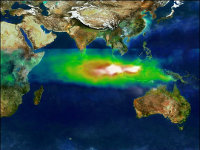Carbon Sinks, Forests and Climate Change
Author and Page information
This print version has been auto-generated from https://www.globalissues.org/article/180/carbon-sinks-forests-and-climate-change
Eighty percent of the forests that originally covered the earth have been cleared, fragmented, or otherwise degraded.
Over the past 150 years, deforestation has contributed an estimated 30 percent of the atmospheric build-up of CO2. It is also a significant driving force behind the loss of genes, species, and critical ecosystem services. However, in the international policy arena, biodiversity loss and climate change have often moved in wholly unconnected domains.
The world's forests and oceans are natural regulators3 of carbon dioxide content in the atmosphere -- which is a greenhouse gas. While forests are regarded as sinks, meaning they absord carbon dioxide, it is hard to rely on forests to soak up increasing pollution4, while forests are increasingly being cut down!
On this page:
Effects of over-deforestation
Forests can provide a natural barrier to disasters such as over-flowing rivers. In China, authorities have admitted5 that excessive felling could have led to the worst case of flooding seen there in 1998. This has resulted in a ban6 on logging in eastern Tibet and an emphasis placed on re-forestation. Bangladesh has seen similar loss of forests and resulting floods too, for example.
The huge forest fires in the Amazon earlier in March, 1998 had already added a lot of Carbon Dioxide7 to the atmosphere, months before the "burning season".

The massive fires in Indonesia that caused enormous pollution and breathing-related illnesses even as far away as Singapore in 1998 and had still been causing problems at least into the middle of 1999.
In East Kalimantan (formerly Borneo) the Dayak people who have had to endure these burning forests, believed to be started by large timber businesses, have seen an ecological disaster that has led to starvation and deaths, as reported by a documentary9 on the politics involved that were related to the environmental issues in that region. This shorter report10 from the International Development Research Center in Canada has some additional information as well.
Forests are vital parts of many ecosystems. Ensuring a healthy ecosystem that includes forests also means sustainable preservation of other species that dwell in forests. As part of a living system, forests rely on these various species, and the various species rely on forests. For more about the importance of such biodiversity, go to this web site's section on Biodiversity11.
Carbon Sinks and Land
A mechanism suggested for tackling climate change and warming has been the idea of using "Carbon Sinks" to soak up carbon dioxide. To aid in this, reforestation, or planting of new forests, have been suggested. This is a popular strategy for the logging industry and nations with large forests interests, such as Canada, the United States, various Latin American nations, and some Asian countries such as Indonesia.
While there may be some potential in this solution, it cannot be effective on its own12. This is because it legitimizes continued destruction of old-growth and pristine forests13 which are rich ecosystem and have an established biodiversity base (albeit shrinking now) that naturally maintain the environment (at no cost!). Creating new forest areas would require the creation of entire ecosystems. It is also criticized for being a quick fix that doesn't tackle the root causes effectively and doesn't lead to, or promote actual emissions reduction.
"This may lead to a new form of colonialism. Forest-planting in Uganda and other poor countries must, firstly, aim to meet the needs of the country and the local people, not the needs of the 'international community.' If this can be combined, it's OK, but experience from similar initiatives show that local interests, local needs, and traditional land rights are easily pushed aside, and that land conflicts arise when outside commercial interests enter."
Environmentalists and others point out that the use of carbon sinks is a big loophole in the Kytoto Protocol; that if carbon sinks can be counted towards emissions reductions credit, then industrialized countries would be able to meet their commitments while reducing emissions by less than would otherwise be required. Because they are carbon sinks, it means that when forests burn or as vegetation naturally dies, they release more carbon too (because it is stored carbon). As the climate changes, it is possible that there may be more forest fires etc, releasing more carbon. (And then these sinks would become sources!)
Well managed soil can also soak up carbon emissions but this too has problems15 to do with land rights, local participation, measuring carbon content etc.
Also, some studies suggest that this carbon dioxide fertilization might not be as effective18 as previously thought, because other important factors such as soil fertility are key to tree growth.
Australia is even using genetically modified trees19 planted in Vietnam to help meet its targets as cheaply as possible. While this sounds like a promising strategy the issue of reducing fuel use and emissions still needs to be addressed, as well as exploiting Vietnam's cheap land and labor for their purposes, and as the previous link reports, "not only threaten local biodiversity, but also cause displacement of indigenous communities and undermine their livelihood."
It is also very difficult to scientifically measure and account the sinks' effects:
"[A]s biologists point out, there is not yet enough data on natural carbon cycling to establish full accounting and verification procedures for carbon sinks. The science simply does not exist to enable prediction of exactly how much carbon is being absorbed by a country's sinks and whether the carbon moving into forests or soils will actually stay there. The procedures would be exceedingly complex, not only because of uncertain science but also because of an accounting maze which would complicate monitoring and enforcement, and encourage governments to fiddle with the figures
Some critics point out that positions like that of the United States, Japan and Canada on carbon sinks is the equivalent to "Doing something about the world's climate problem without having to really do anything."
0 articles on “Carbon Sinks, Forests and Climate Change” and 2 related issues:
Climate Change and Global Warming
 The climate is changing. The earth is warming up, and there is now overwhelming scientific consensus that it is happening, and human-induced. With global warming on the increase and species and their habitats on the decrease, chances for ecosystems to adapt naturally are diminishing. Many are agreed that climate change may be one of the greatest threats facing the planet. Recent years show increasing temperatures in various regions, and/or increasing extremities in weather patterns.
The climate is changing. The earth is warming up, and there is now overwhelming scientific consensus that it is happening, and human-induced. With global warming on the increase and species and their habitats on the decrease, chances for ecosystems to adapt naturally are diminishing. Many are agreed that climate change may be one of the greatest threats facing the planet. Recent years show increasing temperatures in various regions, and/or increasing extremities in weather patterns.
This section explores some of the effects of climate change. It also attempts to provide insights into what governments, companies, international institutions, and other organizations are attempting to do about this issue, as well as the challenges they face. Some of the major conferences in recent years are also discussed.
Read “Climate Change and Global Warming” to learn more.
Environmental Issues
 Environmental issues are also a major global issue. Humans depend on a sustainable and healthy environment, and yet we have damaged the environment in numerous ways. This section introduces other issues including biodiversity, climate change, animal and nature conservation, population, genetically modified food, sustainable development, and more.
Environmental issues are also a major global issue. Humans depend on a sustainable and healthy environment, and yet we have damaged the environment in numerous ways. This section introduces other issues including biodiversity, climate change, animal and nature conservation, population, genetically modified food, sustainable development, and more.
Read “Environmental Issues” to learn more.
Author and Page Information
- Created:
- Last updated:
 Global Issues
Global Issues